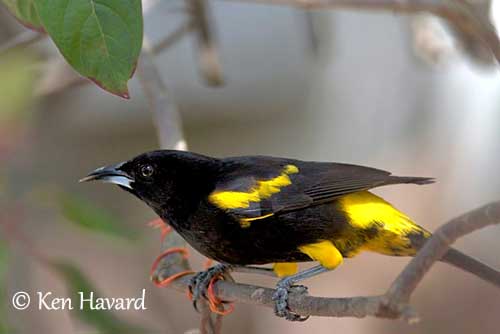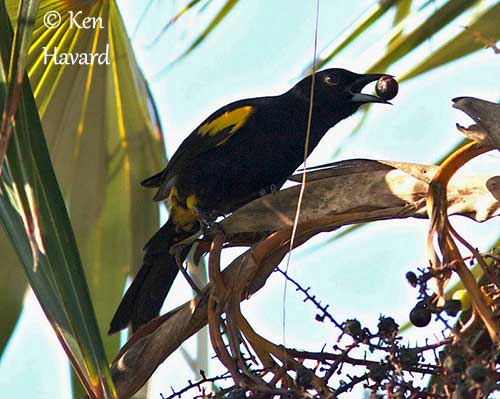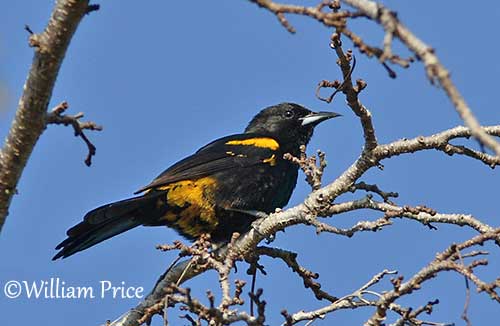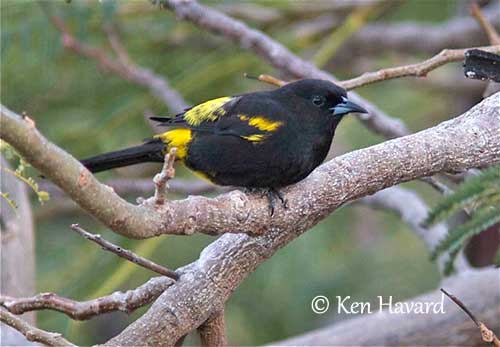
Fr: Oriole de Cuba
Ang: Cuban Oriole
All: Kubatrupial
Esp: Turpial Cubano
Nd: Cubaanse Troepiaal
Sd: kubatrupial
Photographers:
Ken Havard
My Bird Gallery & Flickr gallery 1 & Flickr gallery 2
William Price
PBase-tereksandpiper & Flickr William Price
Text by Nicole Bouglouan
Sources :
HANDBOOK OF THE BIRDS OF THE WORLD Vol 16 by Josep del Hoyo- Andrew Elliot-David Christie – Lynx Edicions – ISBN: 9788496553781
NEW WORLD BLACKBIRDS – THE ICTERIDS by Alvaro Jaramillo and Peter Burke – Helm - ISBN : 0713643331
Neotropical Birds – Cornell Lab of Ornithology
Wikipedia, the free encyclopaedia
Cuban Oriole
Icterus melanopsis
Passeriformes Order – Icteridae Family
INTRODUCTION:
The Cuban Oriole was formerly a subspecies of Icterus dominicensis with other island species from Puerto Rico, Bahama and Hispaniola.
Recent studies, both morphological and behavioural, suggest that these species are now considered full species since 2010. The four new species slightly differ in plumage pattern and range.
The Cuban Oriole is endemic to Cuba where it is threatened by habitat loss, but currently, it is not globally threatened.
DESCRIPTION OF THE BIRD:
Biometrics:
Length: 20 cm
Weight: M: 35-42 g – F: 30-39 g
The Cuban Oriole adult male has black plumage overall, except the yellow rump, lesser and median upperwing-coverts, bend of the wing, thighs and a small spot at the tip of undertail-coverts.
The pointed bill is black, with large blue-grey patch at base of lower mandible. The eyes are brown. Legs and feet are dark blue-grey.

The female resembles male but she is slightly duller.
The juvenile has olive upperparts and olive-green underparts with yellower vent. On the blackish wings, the feathers show greenish-olive edges.
The immature is fairly similar, but it has black chin, throat and lores.
RANGE:
The Cuban Oriole is found in Cuba and Isle of Pine (or Isle of Youth), and also on cays off the northern coast, on Guillermo, Coco and Paredón Grande.
HABITAT:
The Cuban Oriole frequents a variety of habitats including the dense mature native forest, plantations and gardens. It often forages in hedgerows of Erythrina trees.
CALLS AND SONGS: SOUNDS BY XENO-CANTO
The Cuban Oriole utters a clear whistle song that comprises 10-12 descending notes and lasts 2-3 seconds with slightly longer pauses between each song.
The calls include a sharp “chip” and a nasal “wheenk”.
BEHAVIOUR IN THE WILD:
The Cuban Oriole usually forages in thick vegetation. It feeds on nectar from Erythrina flowers by piercing the base of the corolla with the bill to get the nectar, without helping to pollinate them. It takes nectar from several other plants such as Hibiscus, banana, Agave and Citrus. It also consumes soft fruits, insects and invertebrates.

They can be seen in pairs, gleaning invertebrates from leaves and eating soft fruits. They usually visit the largest flowers.
The Cuban Oriole is probably monogamous and nests solitary. The courtship displays of this species are poorly known, but we can suggest that the bright yellow patches of the plumage are enhanced by adapted postures.
Usually, the males of genus Icterus perform courtship displays from a perch, lowering the head, raising the body feathers and spreading wings and tail. These displays are accompanied by songs.
The Cuban Oriole is endemic to Cuba where it is resident.
It has swift, direct flight with rapid wingbeats.
REPRODUCTION OF THIS SPECIES:
The breeding season takes place between February and July. This species may produce 2-3 broods per season. Immature birds have been observed nesting in Cuba.
The nest is often built in palms or banana trees. It is a hanging bag or basket made with string-like plant fibres, mostly from palm leaves. It is attached to the underside of a palm frond. It is suspended from two points, with plant fibres woven through two holes made in the palm leaf. The nest is occasionally suspended from other tree species, but rarely. The nest is usually 16-18 metres above the ground. Both mates build the nest together.

The female lays 3-4 greenish-white eggs with darker spots on the larger end, and she incubates alone, sometimes fed by its mate at or near the nest.
Information about the duration of incubation and nestling period is lacking. However, in most Icterus species, the incubation usually lasts between 11 and 15 days. Both parents feed the chicks. The nestling period lasts about 10 to 14 days.
The Cuban Oriole’s nest is often parasitized by the Shiny Cowbird.
PROTECTION/ THREATS / STATUS:
The Cuban Oriole is relatively common throughout its restricted range, and is able to adapt to modified environment. However, it is threatened by habitat loss through degradation and fragmentation of this habitat.
But currently, the Cuban Oriole is evaluated as Least Concern.
